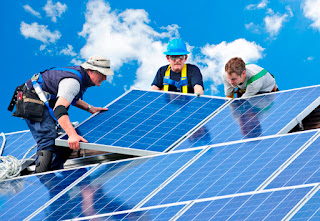‘Going solar’ is seen by many of my friends as the ultimate eco-commitment. Everyone likes to be seen to be doing the right thing and, short of showing your friends your recycling bin or following every offer of a cup of tea with “It’s fair trade and organic!”, it can be hard to demonstrate publicly just how much good you are doing the planet.
But with
solar panel installation, you are literally shouting your green credentials from the rooftops. And no one questions that, right? I mean, there aren’t any downsides to solar - are there?
In fact, the ‘eco math’ that applies to all your other decisions as an ethical consumer needs to extend to your energy, too. You should think about solar the same way you think about food or clothes: where has it come from? How far has it traveled? What conditions was it made under?
So, before you start tweeting smugly about your installation date, do your research carefully and ask your chosen solar company if they can answer these questions…
Are your installers independent?

Solar is like any purchasing decision: you can go big and cheap, or small and personal. Ok, that’s a generalization. But you will find major national companies with sparkling price packages – and impersonal customer service, a lack of specialist experience and small print that quickly undermines the so-called ‘great deal’.
There there are the independents – added value, added expertise and eager to make you happy. These are people who are mad about solar, know everything there is to know about their panels and who will see their relationship with you as long-term. After all, your panels will last more than 20 years!
Are the fitters local?
Ask how far the fitting team will travel. You may be surprised to find out they have been contracted from hundreds of miles away! Think about the carbon footprint of your installation and make sure either the company itself is local, or that it uses a team close to your location.
Where have the panels come from?
This is a big issue and one you really need to think about. One major reason behind the recent explosion in home solar is the drop in installation costs, making it more accessible for more people. On the one hand, this is great news for the planet! But this is where the eco math comes in…
The primary reason behind the price drop is an influx of cheaper Chinese panels into the US and European markets. China’s solar take-over has badly hit domestic US panel manufacturing, with some companies folding. This has become a political hot potato; you may have heard about the erupting trade war between China and America as a result.

Politics aside, choosing a Chinese panel over an American one will obviously inflate the carbon footprint of your purchase. Why buy panels from thousands of miles away when you go to great lengths to source food and other products as locally as possible?
But what if I can only afford cheaper panels?
Darn those ethical maths! Of course, if the price difference between Chinese and other panels prevents you from making the switch then, on balance, getting solar is better than not getting solar at all. But with the right company you might not have to compromise.
Southern Solar for instance, took the provenance of their panels very seriously. They took time to find a Chinese supplier that aligned with their own standards and ethos, so they could feel confident offering the panels to their customers. They chose a supplier that had been around since 1997 – not one of the many new, state-subsidised companies that jumped on the solar bandwagon last year – and checked that they complied with the ISO14001 environmental management system. They also checked the quality was approved by independent testing. These are the kind of criteria you can ask your installer about, too.
Has anything or anyone been badly affected to produce your solar?
Even solar has a dark side. The rapid growth and massive scale of Chinese panel production has led to question marks over workers’ conditions and the environmental impact. They do not have to comply with the comprehensive environmental legislation America and Europe use to make sure manufacturing is safe, sustainable and accountable. There have been reports of pollution spills and increased cancer rates around solar factories, although they remain unsubstantiated by the state.
Don’t be in the dark. All good
solar panel installers should be able to answer these questions and offer you a package that meets your principles as well as your pocket. Make sure that the only regret you feel is that you didn’t make the switch sooner!
In accordance with FTC regulations, we are disclosing that this article was brought to us by a sponsor.














.jpg)







